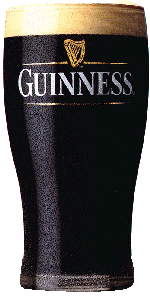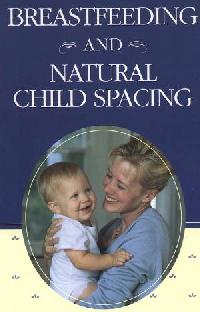 Breastfeeding and Lactation Amenorrhea Tidbits
Breastfeeding and Lactation Amenorrhea Tidbits
Lactation Amenorrhea is the oldest, most widely practiced
method of natural family planning. As one of the articles below

points out, the average spacing (14 months until next pregnancy) is optimum for the mother. You can go right into other NFP methods when normal fertility symptoms return. CCL's recommendations for natural child spacing are below, along with some clippings and odds &ends. Like, the Guinness diet.
The best site to go to for more info on LAM, including a FAQ, 6 dozen real people's experiences, resources, links, articles, and a mailing list, is
Kelly Mayfield's.
SUMMARY OF ECOLOGICAL BREASTFEEDING AND NATURAL CHILD
SPACING PROGRAM
Basic Principles
1. Frequent and unrestricted nursing is the primary factor in producing
natural lactation amenorrhea and infertility. (Lactation amenorrhea is the
absence of menstruation due to breastfeeding.)
2. Ecological breastfeeding (EBF) almost always provides this frequent
nursing and natural infertility. It is that type of baby care which follows
the natural mother-baby relationship. It avoids the use of artifacts and
mother substitutes; it follows the baby-initiated patterns. EBF is the norm
and offers many built-in benefits, one of which is extended natural infertility.
In essence, a lengthy postpartum amenorrhea is the expected norm.
Phase I of Ecological Breastfeeding: The Seven Standards
This phase almost invariably produces natural infertility as long as
the program is complete. Phase I usually lasts six months. The key to natural
infertility is frequent and unrestricted nursing. The following Seven Standards
help to ensure this frequent nursing.

1 . Do exclusive breastfeeding for the first six months of life; don't
use other liquids and solids.
2. Pacify your baby at your breasts.
3. Don't use bottles and pacifiers.
4. Sleep with your baby for night feedings.
5. Sleep with your baby for a daily-nap feeding.
6. Nurse frequently day and night, and avoid schedules.
7. Avoid any practice that restricts nursing or separates you from
your baby.
Phase II of Ecological Breastfeeding: The Six Standards
• Phase II of EBF begins when your baby starts taking solids or liquids
other than breastmilk.
• You begin to give liquids when your baby shows an interest in the
cup, usually after six months.
• Aside from Standard # 1, exclusive breastfeeding, the other Six Standards
of Phase I will remain operative until the baby gradually loses interest in
breastfeeding. Phase 11 is a very gradual program in which the amount of
nursing is 1) not decreased at all at first, and 2) lessened only gradually
at baby's pace. Phase 11 is frequently longer than Phase I with regard to
natural infertility if EBF continues with frequent and unrestricted nursing.
Return of Fertility
The First 6 Months. The first 8 weeks postpartum for
the exclusively breastfeeding mother are so infertile that in 1988 scientists
agreed that any vaginal bleeding during the first 56 days postpartum can
be ignored for determining amenorrhea or fertility for the exclusively breastfeeding
mother. This rule would also apply to the EBF mother.
During the first 3 months postpartum, the chance of pregnancy
occurring is practically nil if the EBF mother remains in amenorrhea.
During the next 3 months postpartum, there is only a I % chance
of pregnancy if the EBF mother continues to remain in amenorrhea.
After 6 Months. For the nursing mother there is about a 6% chance
of pregnancy occurring prior to the first menstruation. This assumes no fertility
awareness and unrestricted intercourse. This risk can be reduced to close
to 1% through the techniques of systematic natural family planning-observing
the signs of fertility and abstaining accordingly.
About 70% of EBF mothers experience their first menstruation between
9 and 20 months postpartum. The average return of menstruation for EBF mothers
is between 14 and 15 months.
Natural Spacing by Breastfeeding Alone
For those couples who desire 18 to 30 months between the births of
their children, ecological breastfeeding should be sufficient.
Copyright 2000 by CCLI
Inc. Adapted from Breastfeeding and Natural Child Spacing by Sheila K. Kippley
1999 (Couple to Couple League), This book explains the above principles and
helps mothers to accomplish this form of childcare in contemporary Western
culture. To order on Visa, MasterCard or Discover, call 1-800-745-8252 or
go to the CCL website. Permission is given to copy this document provided
it is reproduced in full.

Increasing Milk Flow: Here's some tips for better lactation, none of them with our guarantee.
But, consider that overall good nutrition and lots of water are beneficial.
From the notebook of Mark Hayden, formerly of CCL (6/2000). If you have
good luck with one of these, let us know.
Here's some tips for better lactation, none of them with our guarantee.
But, consider that overall good nutrition and lots of water are beneficial.
From the notebook of Mark Hayden, formerly of CCL (6/2000). If you have
good luck with one of these, let us know.
Dark beer (such as Guinness or Heineken Dark), can help increase breast
milk volume. These are typically high in B vitamins and hops.
Limit the consumption to one a day. The hops will help stimulate milk production
(Herbal Healing for Women; Rosemary Gladstar; Simon and Schuster,
1993).
Nutritional Approach (Marilyn Shannon)
Professional Prenatal Formula or the equivalent, especially in B vitamins.
Dietary Approach (Herbal Remedies for Women: Amanda McQuade
Crawford; Prima Publishing, 1997).
Oatmeal, seeds, nuts, whole grains, and sprouted seeds and legumes (alfalfa,
etc.,). These provide B-vitamins. Plant proteins, fatty acids,
and mildly estrogenic plant compounds to nourish a mother and provide rich
milk for the baby.
Herbal Approach (Herbal Healing for Women; Rosemary Gladstar;
Simon and Schuster, 1993).
Blessed Thistle Tea
1 part blessed thistle 2 parts nettle
4 parts fennel seeds 2 parts raspberry
leaf
Use 4 to 6 tbs. of herb mixture per quart of water. Add to cold water
and bring to slow boil. Remove from heat and steep for 20 minutes.
Drink 3 to 4 cups daily.
A tea of crushed fennel, anise, caraway, cumin, dill or fenugreek are all
excellent for increasing milk flow and reducing colic. (Natural Remedy Bible,
Lust and Tierra; Pocket Books, 1990 {excellent resource}).
Aromatherapy approach
Massage oil to increase the milk flow ( The Complete Book of Essential
Oils & Aromatherapy, Valerie Worwood; New World Library,
1991).
15 drops fennel or 15 drops geranium or 10 drops clary-sage
Use only 1 oil and dilute it in 2 tbs. of a good nut or vegetable oil.
Massage the breasts in a circular motion, starting under the arms, working
inward and downward and then up between the cleavage. Do this once
a day. Remember to wash the oil off before feeding the baby.

WHO Encourages Breastfeeding
The World Health Organization accepted in May 2001 a resolution recommending
infants be exclusively breast-fed for 6 months. The resolution urges member
states to "support exclusive breastfeeding for 6 months as a global public
health recommendation...and to provide safe and appropriate complementary
foods, with continued breastfeeding for up to 2 years or beyond."
"This is a key moment, and not just for the developing world. The scientific
evidence continues to confirm the importance and value of exclusive breast-feeding,
and this will help our efforts to achieve optimal maternal and infant health
everywhere," said Dr. Audrey Naylor, President of Wellstart International.
Many national delegates and several charities and organizations spoke
strongly about the health benefits of breast-feeding. Nestle representatives
accepted the resolution without question. The controversial maker of infant
formula has been the target of protests by pro-breastfeeding groups.

Breast-Feeding Cuts Risk of Respiratory Disease - 10/23/2001
If you breast-feed for at least 4 months, your child will experience one
third the risk of hospitalization for lower respiratory disease, according
to a literature review paper presented at the American Academy of Pediatricians
annual meeting by Dr. Virginia Bachrach. The protection seems to last for
the first year of life.
She said that 6% of all US infants younger than 1 year of age are hospitalized
annually for lower respiratory tract disease, which elevates their risk for
later illnesses, such as asthma, and creates a costly healthcare burden.
Children who are breast-fed receive a boost to their immune systems from their
mothers, which may help them ward off infectious viruses that cause respiratory
illness.

Study shows 1-1/2 to 2 year pregnancy spacing is best
A 1999 study by the Centers for Disease Control and Prevention found that
while having babies too close together can be bad for an infant's health,
having them too far apart may be even worse. Both situations raise the risk
that the new baby will be premature or small, which can cause long-term
health problems, even death.
The CDC study calculated that waiting 18 to 23 months after giving birth
to get pregnant again is best. That works out to about 2 1/2 years between
children.
"Somehow the body knows that this interval is good for the health of the
infant," said Dr. Bao-Ping Zhu, who directed the study. "The delivery
is like running for the marathon. You don't want to have two deliveries
too close together ... otherwise the body will be tired and the birth outcomes
are not likely to be good," Zhu said. "On the other hand, you don't want
to wait too long, either."
Spacing children a couple of years apart is popular with parents so they
won't have two children in diapers, yet the kids will be close enough in
age to play together when they get older.
Compared with babies born during the ideal interval, those whose moms became
pregnant again within six months had a 30 percent to 40 percent greater
chance of producing premature or undersize babies. However, those who waited
10 years for another child were twice as likely to have an unusually small
baby and 50 percent more likely to deliver prematurely.
Zhu said babies conceived too soon probably have problems because the mother
is recovering from vitamin depletion, blood loss and reproductive system
damage from the prior birth -- all while stressed by having to care for a
newborn.
His theory is that the reason getting pregnant after a long interval is
risky is that the body becomes primed for birth during the earlier pregnancy,
with the uterus enlarging and blood flow to the womb increasing, but those
benefits
decline over time.
The results were published in the May 1999 New England Journal of Medicine.
The American College of Obstetricians and Gynecologists says that waiting
1 1/2 to two years between births is best.

Breastfeeding Reduces Risk of Breast Cancer
Breast-feeding reduces the risk of breast cancer, according to a report
published in the American Journal of Epidemiology. (Am J Epidemiol 2001;154:37-42.)
There was an inverse relationship between breast-feeding duration and the
risk of breast cancer. For women diagnosed after 40 years of age, the association
was much weaker, the authors note. The risk of breast cancer at all ages appeared
to be lower for women who had ever lactated versus those who had not.
"The present results, in the context of results from previous studies, indicate
that breast-feeding reduces the risk of breast cancer diagnosed under the
age of 40, and it may offer some protection for older cases also," the researchers
state.


 points out, the average spacing (14 months until next pregnancy) is optimum for the mother. You can go right into other NFP methods when normal fertility symptoms return. CCL's recommendations for natural child spacing are below, along with some clippings and odds &ends. Like, the Guinness diet.
points out, the average spacing (14 months until next pregnancy) is optimum for the mother. You can go right into other NFP methods when normal fertility symptoms return. CCL's recommendations for natural child spacing are below, along with some clippings and odds &ends. Like, the Guinness diet.